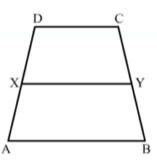In ABC , prove that tanA+tanB+tanC≥3√3,whereA,B,C are acute angles.
In ΔABC,
tan−A+tanB+tanC=tanAtanBtanC
Also,
tanA+tanB+tanC3≥3√tanAtanBtanC
or tanAtanBtanC≥3√tanAtanBtanC
or tan2Atan2Btan2C≥27
or tanAtanBtanC≥3√3
or tanA+tanB+tanC≥3√3 .
Topper's Solved these Questions
- INEQUALITIES INVOLVING MEANS BOOK - CENGAGECHAPTER - INEQUALITIES INVOLVING MEANS EXERCISE - Exercise 6.3
6 Videos
- INEQUALITIES INVOLVING MEANS BOOK - CENGAGECHAPTER - INEQUALITIES INVOLVING MEANS EXERCISE - Exercise 6.4
4 Videos
- INEQUALITIES INVOLVING MEANS BOOK - CENGAGECHAPTER - INEQUALITIES INVOLVING MEANS EXERCISE - Exercise 6.1
8 Videos
- INEQUALITIES AND MODULUSBOOK - CENGAGECHAPTER - INEQUALITIES AND MODULUSEXERCISE - Single correct Answer
21 Videos
- INTEGRALSBOOK - CENGAGECHAPTER - INTEGRALSEXERCISE - Solved Examples And Exercises
324 Videos
Similar Questions
In ΔABC , prove that tanA+tanB+tanC≥3√3,whereA,B,C are acute angles.
View SolutionProve that in ΔABC tanA+tanB+tanC≥3√3; where A;B;C are acute angles.
View SolutionProve that in ABC,tanA+tanB+tanC≥3√3, where A,B,C are acute angles.
View SolutionIf A+B+C=180∘ , then tanA+tanB+tanCtanA tanB tanC is equal to tanAtanBtanC b. 0 c. 1 d. none of these
View SolutionIn triangle ABC,po∈tsD,EandF are taken on the sides BC,CAandAB, respectigvely, such that BDDC=CEEA=AFFB=n. Prove that _(DEF)=n2−n+1((n+1)2)ABC.
View SolutionStatement 1 is True: Statement 2 is True; Statement 2 is a correct explanation for statement 1 Statement 1 is true, Statement 2 is true;2 Statement 2 not a correct explanation for statement 1. Statement 1 is true, statement 2 is false Statement 1 is false, statement 2 is true Statement I: If A is obtuse angle I ABC, then tanB tanC<1 because Statement II: In ABC, tanA=tanB+tanCtanBtanC−1 a.A b. B c. C d. D
View Solutionprove that ∣∣→a×→b∣∣=(→a.→b)tanθ, where θ is the angle between →a and →b.
View SolutionIf A>0, B>0 and A+B= π6 , then the minimum value of tanA+tanB is: 2−√3 b. 4−2√3 c. √3−√2 d. 2√3
View SolutionIn Figure, ABCD is a trapezium in which AB,DCandDC=40cmandAB=60cm If XandY are, respectively, the mid-points of ADandBC, prove that: ar(traptDCYX)=911,ar(trap(XYBA)

View SolutionIn isosceles triangles ABC,∣∣→AB∣∣=∣∣→BC∣∣=8, a point E divides AB internally in the ratio 1:3, then find the angle between →CEand→CA(where∣∣→CA∣∣=12).
View Solution
